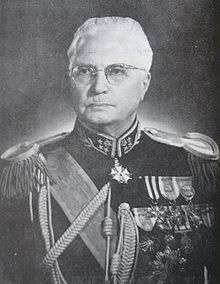Amanullah Jahanbani
Sepahbod Amanollah Jahanbani (Persian: سپهبد امانالله جهانبانى; 1891 – 1 February 1974) was a member of the Qajar dynasty and a senior general of Reza Shah Pahlavi.
Amanullah Jahanbani | |
|---|---|
 Amanullah Jahanbani | |
| Minister of War | |
| In office 9 March 1942 – 9 August 1942 | |
| Monarch | Mohammad Reza Pahlavi |
| Prime Minister | Ali Soheili |
| Minister of Interior | |
| In office 27 August 1941 – 9 March 1942 | |
| Monarch | Mohammad Reza Pahlavi |
| Prime Minister | Mohammad Ali Foroughi |
| Minister of Roads | |
| In office 27 August 1941 – 9 March 1942 | |
| Monarch | Mohammad Reza Pahlavi |
| Prime Minister | Mohammad Ali Foroughi |
| Member of the Iranian Senate | |
| In office 19 August 1951 – 1 February 1974 | |
| Personal details | |
| Born | 1891 Tehran, Iran |
| Died | 1 February 1974 (aged 83) Robat Karim, Tehran, Iran |
| Nationality | Iranian |
| Children | Masoud Mirza, Hossein Mirza, Hamid Mirza, Nader, Majid, Parviz, Mahmoud, Khosrow |
| Military service | |
| Allegiance | |
| Branch/service | Imperial Iranian Army |
| Years of service | 1902–1937 |
| Rank | Lieutenant general |
Early life and education
Jahanbani was born in 1895. He was the great grandson of Fath Ali Shah.[1] At the age of 10, Jahānbāni was sent to St. Petersburg for schooling, where he attended the Mihailovsky Artillery College and the Nikolaevsky War Academy. He returned to Iran as a ranked military officer in World War I.
He furthermore served in the Persian Cossack Brigade and was a pivotal figure in the 1921 Persian coup d'état.
Career
During a second trip, after completing his studies in Europe, Jahanbani became a major general in the Armed Forces. He was appointed the chief of the staff with the rank of brigadier general at the beginning of the 1920s.[2] In 1928, he led the army in Balochistan attack to control the resistance.[3] His path of success continued until 1938, when he fell out of favor and was suddenly thrown into the Qasr prison by Reza Shah Pahlavi.[4] However, in 1941 he was interior minister.[5]
With Reza Shah's abdication during World War II, his political life saw some luck again and he was appointed to the Senate during the era of Mohammad Reza Shah Pahlavi where he served during five consecutive periods.
Personal life and death
Jahanbani married twice. He had nine children. His first wife, Helen Kasminsky, bore him four children; Nader, Parviz, Khosrow, and Mehr Moneer. Nader became the deputy head of the Imperial Iranian Air Force, Parviz was an officer in the Imperial Iranian Marines, and Khosrow is the second husband of Princess Shahnaz Pahlavi. Amanullah is the father-in-law of Captain Nasrollah Amanpour, the uncle of CNN journalist Christiane Amanpour.[6]
Jahanbani died in 1974 at the age of 83.
Jahanbani wrote the book "Iranian Soldier: Meaning of Water and Soil", the story of his life periods like, educating and serving. this book published in 2001 with efforts of his son Parviz Jahanbani. [7]
References
- "Centers of Power in Iran" (PDF). CIA. May 1972. Retrieved 5 August 2013.
- Stephanie Cronin (2006). Tribal Politics in Iran: Rural Conflict and the New State, 1921-1941. Routledge. p. 62. ISBN 978-1-134-13801-2.
- Naseer Dashti (2012). The Baloch and Balochistan: A Historical Account from the Beginning to the Fall of the Baloch State. Trafford Publishing. p. 280. ISBN 978-1-4669-5897-5.
- Ervand Abrahamian (1999). Tortured Confessions: Prisons and Public Recantations in Modern Iran. University of California Press. p. 46. ISBN 978-0-520-92290-7.
- Mohammad Gholi Majd (2012). August 1941: The Anglo-Russian Occupation of Iran and Change of Shahs. University Press of America. p. 360. ISBN 978-0-7618-5940-6.
- News Fars News
- ""Iranian Soldier: Meaning of Water and ground"".
Other sources
- 'Alí Rizā Awsatí (عليرضا اوسطى), Iran in the Past Three Centuries (Irān dar Se Qarn-e Goz̲ashteh - ايران در سه قرن گذشته), Volumes 1 and 2 (Paktāb Publishing - انتشارات پاکتاب, Tehran, Iran, 2003). ISBN 964-93406-6-1 (Vol. 1), ISBN 964-93406-5-3 (Vol. 2).